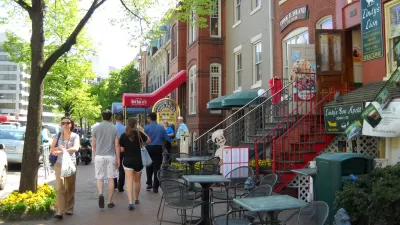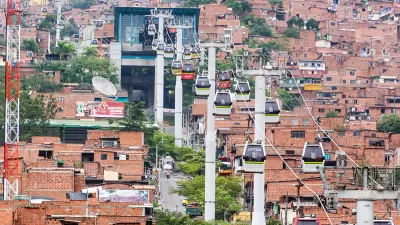Homicides rose across the nation in 2020 and 2021 but began to ebb in 2022 and 2023. Have these trends played out equally across all cities, or were they worse in cities controlled by one political party or the other?

Editor’s note: This blog was updated on September 19, 2024 to reflect 2023 U.S. crime rate data and trends.
In 2020, the national homicide rate rose 30 percent. Homicides continued to increase in most cities in 2021, but the tide of violence began to ebb over the last two years.
Naturally, this tragedy has become a political football, and at least two contending narratives have arisen to explain what went wrong. Republican media tend to favor a “bad blue city” narrative. According to this story, crime is the result of progressive permissiveness in Democrat-run cities and states. By contrast, Democratic media tend to claim that crime is a problem everywhere, caused by some mix of COVID-related madness and increased gun purchases. But has urban crime really risen more in Democratic cities? And if so, are all blue cities the same, or are the most progressive cities in America especially problematic?
How do we define a red city vs. a blue city?
The American Violence website contains homicide and shooting data for 90 large and medium-sized cities. It seems that American cities can be divided into multiple groups, beyond even red cities and blue cities:
- Red cities: cities with Republican mayors. These cities include Fresno, Fort Worth, Oklahoma City, Omaha, Tulsa,, Miami, Bakersfield, Stockton, Lexington, and Lubbock (Numerous other mid-sized cities, such as Virginia Beach and Mesa, also have Republican mayors, but I am only counting urban cores, and municipalities such as Mesa are basically suburbs of more traditional cities. Also, the mayor of Dallas recently switched parties so I am still counting him as a Democrat). *
- Dense cities: Cities with unusually high densities and historically high transit ridership (New York, Boston, San Francisco, Chicago, Washington, Philadelphia). These cities tend to have become more left-wing in recent decades.
- Other progressive cities: cities other than the cities in (2) that seem to have a reputation for being somewhat more progressive than most non-red cities. (I haven’t thought of any more precise way of distinguishing progressive cities from moderate ones, but maybe I am missing something here!) My educated guess is that this group includes include Seattle, Portland, Austin, Minneapolis, Oakland, and Los Angeles.
- Black cities: Cities (outside group 2) that are majority Black—Baltimore, Detroit, Memphis, Baton Rouge and Cleveland.. I also include Atlanta in this category, since it is almost half Black and has had Black mayors for half a century. I separated these cities from group 3 because Blacks are not always as socially left-wing as white progressives, so I thought it was possible that these cities might have different results than those in group 3.
- “One big suburb” cities: A group of cities tend to be like Republican-run cities in many ways: most of them have annexed hundreds of miles of suburban territory, which makes their politics somewhat more centrist. They tend to be in the South and West but there are a couple of Midwestern exceptions.
I note that some cities don’t fit into any of these categories. Rust Belt cities like Pittsburgh and Buffalo are too white for category 4, have annexed too little suburbia for category 5, are not dense enough for category 2, and not left-wing enough for category 3. I have also excluded cities with nonpartisan mayors and cities that are basically suburbs of other cities (like Mesa).
Which are the most dangerous cities in America?
In four of the ten Republican-run core cities (Lexington, Tulsa, Miami and Oklahoma City), homicides actually fell between 2019 and 2023. But the others present a mixed picture: homicide rose by 1 percent in Fresno, 5 percent in Lubbock, 8 percent in Fort Worth and Omaha, about 14 percent in Bakersfield, and 28 percent in Stockton. So the median red-city homicide increase is 1–5 percent, although there’s a pretty wide variation between the best and worst cities.
I also note that these increases are from a fairly low base, because no red city has an insanely high homicide rate: the most deadly, Stockton, had 13 murders per 100,000 residents in 2023, the 30th highest among the 90 cities listed by American Violence.I suspect this has something to do with the fact that most of the Republican cities have annexed huge chunks of middle-class suburbia. Only two of the ten red cities (Stockton and Miami) include less than 100 square miles.
What about the six dense cities? Homicides fell between 2019 and 2023 in only one of the six (Boston). Homicides increased by almost 60 percent in Washington, just over 30 percent in Chicago and San Francisco, 14 percent in New York, and 12 percent in Philadelphia. To put it another way, the median homicide increase in this group was over 30 percent — from a fairly high base in the case of Chicago, Philadelphia, and Washington, but from a fairly low base in the case of the other three cities. (San Francisco, New York and Boston all have lower homicide rates than Stockton).
What about progressive cities? Crime rose more here than in either the dense cities or the Republican cities. In all of my six progressive cities, homicides rose by over 30 percent. Homicides rose by 32 percent in Los Angeles, 64 percent in Oakland, 51 percent in Minneapolis, 85 percent in Seattle, 99 percent in Austin, and over 100 percent in Portland in all cases, from a relatively low base. (Even after these massive increases, four of the six cities were safer than Stockton). If I’m right in assuming that these cities are more left-wing than my Group 4 and 5 cities, then the correlation between leftish politics and rising crime might be significant. (But that’s a big if, especially since I’m talking about a pretty small group of cities).
By contrast, the Black cities were a mixed bag. The murder rate actually decreased in Baltimore and Detroit. On the other hand, homicide rates rose by 87 percent in Memphis, 45 percent in Cleveland, 20 percent in Baton Rouge and 29 percent in Atlanta. In Rust Belt cities with large-but-not-majority-Black populations, there was also no clear pattern: homicides nearly doubled in Milwaukee but declined in Buffalo, Cincinnati, and St. Louis.
The last and largest group is a mix of cities that are currently run by Democrats but that tend to be more suburb-dominated and less known for progressivism than Portland or San Francisco. This group include five cities where murders decreased (including Long Beach, El Paso, Charlotte, San Jose and San Diego), as well as Durham (2 percent increase), Dallas (6 percent increase), Sacramento (10 percent increase), Indianapolis (11 percent), Kansas City (13 percent), Nashville (16 percent), Raleigh (18 percent), Houston (20 percent), Albuquerque (ditto), Denver (21 percent), Winston-Salem (ditto), Tampa (23 percent), Fort Wayne (32 percent), St. Petersburg (ditto), Phoenix (50 percent increase), Lincoln (54 percent, but from a very low base), and Greensboro (57 percent). In this large group, the median increase was in the high teens — more than in most Republican cities, less than in the progressive cities.
What's the verdict?
In sum, it seems that by 2023 a pattern has emerged: very mild homicide increases in cities with Republican mayors, large increases in the most progressive lower-density cities, and a more mixed pattern in other types of cities with Democratic mayors. However, there does seem to be considerable overlap between the Republican-run cities and the other categories: at least one city in Groups 2, 4 ,and 5 also experienced decreases. A more scientific study would find ways to distinguish progressive cities from moderate ones a bit more precisely, and might involve a larger sample size.
Editor's note: For an analysis of violent crime trends in Europe and the drivers behind them, check out Michael's But... Europe blog post.

Trump Administration Could Effectively End Housing Voucher Program
Federal officials are eyeing major cuts to the Section 8 program that helps millions of low-income households pay rent.

Planetizen Federal Action Tracker
A weekly monitor of how Trump’s orders and actions are impacting planners and planning in America.

Ken Jennings Launches Transit Web Series
The Jeopardy champ wants you to ride public transit.

California Invests Additional $5M in Electric School Buses
The state wants to electrify all of its school bus fleets by 2035.

Austin Launches $2M Homelessness Prevention Fund
A new grant program from the city’s Homeless Strategy Office will fund rental assistance and supportive services.

Alabama School Forestry Initiative Brings Trees to Schoolyards
Trees can improve physical and mental health for students and commnity members.
Urban Design for Planners 1: Software Tools
This six-course series explores essential urban design concepts using open source software and equips planners with the tools they need to participate fully in the urban design process.
Planning for Universal Design
Learn the tools for implementing Universal Design in planning regulations.
Ada County Highway District
Clanton & Associates, Inc.
Jessamine County Fiscal Court
Institute for Housing and Urban Development Studies (IHS)
City of Grandview
Harvard GSD Executive Education
Toledo-Lucas County Plan Commissions
Salt Lake City
NYU Wagner Graduate School of Public Service






























